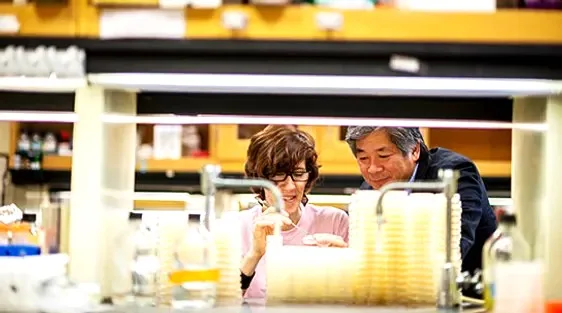Power of HSF1 in Halting Protein Misfolding and Reversing Aging
HSF1 (Heat Shock Transcription Factor 1) is a potential ally that scientists have discovered in their quest to stop the aging process. This amazing compound is essential in the fight against misfolding of proteins, which is a process that is closely associated with a number of age-related illnesses, including numerous neurodegenerative conditions. Our cells gather misfolded protein aggregates with age, which causes progressive cell damage and organ dysfunction. HSF1 activation, on the other hand, has come to light as a potential cure for aging by providing a means of restoring proteostasis.

Understanding the Enemy: Protein Misfolding
Protein misfolding is akin to a production line gone awry. In a healthy cell, proteins fold into precise shapes to perform their specific functions. However, errors can occur, resulting in misfolded proteins that aggregate and wreak havoc within the cell. These aggregates are not just cellular clutter; they are actively harmful, disrupting cellular function and contributing to diseases like Alzheimer’s and Parkinson’s.
HSF1: The Guardian of Cellular Integrity
Enter HSF1, the guardian of cellular integrity. This transcription factor is a key player in the cell’s defense against the chaos of protein misfolding. When protein folding stress is detected, HSF1 springs into action, initiating the heat-shock response (HSR). This response is the cell’s emergency protocol to restore order, inducing the expression of chaperone genes that help refold misfolded proteins and reestablish cellular homeostasis.
The Mechanism of Action: How HSF1 Works
HSF1 operates through a fascinating mechanism. Misfolded proteins can bind to chaperones associated with HSF1, freeing HSF1 to form trimers and enter the nucleus. This triggers the activation of heat shock protein (Hsp) gene transcription, effectively rebalancing proteostasis and dialing down the heat shock response.
The initial activation of HSF1 is prompted by heat shock, which increases the demand for chaperones to prevent protein misfolding. This, in turn, releases HSF1 from its complex with Hsp90, kick-starting the entire process. The result is a powerful, self-regulating system capable of responding to the stress of misfolded proteins and restoring balance within the cell.
The Potential for Reversing Aging
The implications of HSF1’s role in halting protein misfolding are profound. By activating HSF1, it may be possible to not only prevent the accumulation of misfolded protein aggregates but also reverse some of the cellular damage they cause. This opens up exciting avenues for research into anti-aging therapies, with the potential to improve the quality of life for millions of people suffering from age-related diseases.
The Road Ahead
While the potential of HSF1 in reversing aging is immense, there is still much to learn. Ongoing research is crucial to fully understand the mechanisms by which HSF1 can be effectively activated and harnessed for therapeutic purposes. The journey to unlock the secrets of youth continues, with HSF1 leading the way as a powerful tool in the fight against aging and neurodegenerative diseases.
In summary, HSF1 represents a promising frontier in the battle against aging and protein misfolding diseases. Its ability to restore cellular balance and prevent damage caused by protein aggregates offers hope for the development of new, more effective treatments for age-related conditions. As science delves deeper into the mysteries of HSF1, we inch closer to unlocking the potential for healthier, more youthful cells, even as we age.
References:
Faraonio R., Salerno P., Passaro F., Sedia C., Iaccio A., Bellelli R., et al.. (2012). A set of miRNAs participates in the cellular senescence program in human diploid fibroblasts. Cell Death Differ. 19, 713–721. doi: 10.1038/cdd.2011.143, PMID: [PMC free article] [PubMed] [CrossRef] [Google Scholar]
Ferreira J. C. B., Mori M. A., Gross E. R. (2019). Mitochondrial bioenergetics and quality control mechanisms in health and disease. Oxidative Med. Cell. Longev. 2019:5406751. doi: 10.1155/2019/5406751 [PMC free article] [PubMed] [CrossRef] [Google Scholar]
Gendron T. F., Petrucelli L. (2009). The role of tau in neurodegeneration. Mol. Neurodegener. 4:13. doi: 10.1186/1750-1326-4-13, PMID: [PMC free article] [PubMed] [CrossRef] [Google Scholar]
Kushnirov V. V., Alexandrov I. M., Mitkevich O. V., Shkundina I. S., Ter-Avanesyan M. D. (2006). Purification and analysis of prion and amyloid aggregates. Methods 39, 50–55. doi: 10.1016/j.ymeth.2006.04.007 [PubMed] [CrossRef] [Google Scholar]
LeVine H. (1993). Thioflavine T interaction with synthetic Alzheimer’s disease beta-amyloid peptides: detection of amyloid aggregation in solution. Protein Sci. 2, 404–410. doi: 10.1002/pro.5560020312, PMID: [PMC free article] [PubMed] [CrossRef] [Google Scholar]

I sincerely enjoyed what you have produced here. The design is refined, your authored material trendy, yet you appear to have obtained a degree of apprehension regarding what you aim to offer next. Certainly, I shall return more frequently, just as I have been doing almost constantly, provided you uphold this incline.